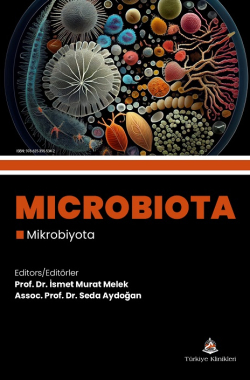INTRAUTERINE GROWTH RESTRICTION AND THE GUT MICROBIOTA
Funda Yavanoğlu Atay
Ümraniye Training and Research Hospital, Department of Neonatal Intensive Care, İstanbul, Türkiye
Yavanoğlu Atay F. Intrauterine Growth Restriction and the Gut Microbiota. Melek İM, Aydoğan S, eds. Microbiota. 1st ed. Ankara: Türkiye Klinikleri; 2025. p.57-62.
ABSTRACT
Intrauterine Growth Restriction (IUGR) / fetal growth restriction (FGR) is a condition characterized by the inability of the fetus to reach its growth potential, most commonly due to placental insufficiency. IUGR infants are at increased risk for various long-term health complications, including metabolic disorders, cardiovascular diseases, immune dysfunctions, and neurodevelopmental delays. Recent research highlights the crucial role of the gut microbiota in early life, influencing immune system development, metabolism, and neurodevelopment. This review explores the relationship between IUGR and gut microbiota, focusing on the negative impact of dysbiosis in IUGR infants. It discusses the implications of dysbiosis on immune maturation, cognitive development, and the risks associated with catch-up growth. Therapeutic strategies, such as breastfeeding, probiotics, prebiotics, and fecal microbiota transplantation, are reviewed as potential interventions to restore gut balance and improve the health outcomes of IUGR infants. Understanding the gut microbiota’s role in IUGR can help guide more effective treatments and promote optimal growth and development in this vulnerable population.
Keywords: Fetal growth retardation; Gastrointestinal microbiome; Infant; Newborn; Dysbiosis; Intestine; Small
Kaynak Göster
Referanslar
- Sharma D, Shastri S, Farahbakhsh N, Sharma P. Intrauterine growth restriction - part 1. J Matern Fetal Neonatal Med. 2016;29(24):3977-3987. [Crossref] [PubMed]
- Figueras F, Gardosi J. Intrauterine growth restriction: new concepts in antenatal surveillance, diagnosis, and management. Am J Obstet Gynecol 2011;204:288-300. [Crossref] [PubMed]
- Platz E, Newman R. Diagnosis of IUGR: traditional biometry. Semin Perinatol 2008;32:140-7. [Crossref] [PubMed]
- Dashe JS, McIntire DD, Lucas MJ, Leveno KJ. Effects of symmetric and asymmetric fetal growth on pregnancy outcomes. Obstet Gynecol 2000;96:321-7. [Crossref] [PubMed]
- Kesavan K, Devaskar SU. Intrauterine grow th restriction: Postnatal monitoring and outcomes. Pediatric Clinics of North America. 2019;66(2),403-423. [Crossref] [PubMed]
- An J, Wang J, Guo L, et al. The Impact of Gut Microbiome on Metabolic Disorders During Catch-Up Growth in Small-for-Gestational-Age. Front Endocrinol (Lausanne). 2021;12:630526. Published 2021 Mar 4. [Crossref] [PubMed] [PMC]
- Bogaert D, van Beveren GJ, de Koff EM, Lusarreta Parga P, Balcazar Lopez CE, et al. Mother-to-infant microbiota transmission and infant microbiota development across multiple body sites. Cell Host & Microbe. 32023;1(3);447-460. [Crossref] [PubMed]
- Sarkar A, Yoo JY, Valeria Ozorio Dutra S, Morgan KH, Groer M. The Association between Early-Life Gut Microbiota and Long-Term Health and Diseases. J Clin Med. 2021;10(3):459. Published 2021 Jan 25. [Crossref] [PubMed] [PMC]
- Dominguez-Bello MG, Godoy-Vitorino F, Knight R, Blaser MJ. Role of the microbiome in human development. Gut. 2019;68(6):1108-1114. [Crossref] [PubMed] [PMC]
- Browne HP, Shao Y, Lawley TD. Mother-infant transmission of human microbiota. Curr Opin Microbiol. 2022;69:102173. [Crossref] [PubMed]
- Terrazzan Nutricionist AC, Procianoy RS, Roesch LFW, Corso AL, Dobbler PT, Silveira RC. Meconium microbiome and its relation to neonatal growth and head circumference catch-up in preterm infants. PLoS One. 2020;15(9):e0238632. Published 2020 Sep 21. [Crossref] [PubMed] [PMC]
- Escobedo G, López-Ortiz E, Torres-Castro I. Gut microbiota as a key player in triggering obesity, systemic inflammation and insulin resistance. Rev Invest Clin. 2014;66(5):450-459. [PubMed]
- Thomas RM, Linch DC. Identification of lymphocyte subsets in the newborn using a variety of monoclonal antibodies. Arch Dis Child. 1983;58(1):34-38. [Crossref] [PubMed] [PMC]
- Groer MW, Luciano AA, Dishaw LJ et al. Development of the preterm infant gut microbiome: a research priority. Microbiome 2014;2:38. [Crossref] [PubMed] [PMC]
- Yang J, Hou L, Wang J, et al. Unfavourable intrauterine environment contributes to abnormal gut microbiome and metabolome in twins. Gut. 2022;71(12):2451-2462. [Crossref] [PubMed] [PMC]
- Fança-Berthon P, Hoebler C, Mouzet E, David A, Michel C. Intrauterine growth restriction not only modifies the cecocolonic microbiota in neonatal rats but also affects its activity in young adult rats. J Pediatr Gastroenterol Nutr. 2010;51(4):402-413. [Crossref] [PubMed]
- Trebichavsky I, Rada V, Splichalova A, Splichal I. Cross-talk of human gut with bifidobacteria. Nutr Rev. 2009;67(2):77-82. [Crossref] [PubMed]
- Huang S, Li N, Liu C, et al. Characteristics of the gut microbiota colonization, inflammatory profile, and plasma metabolome in intrauterine growth restricted piglets during the first 12 hours after birth. J Microbiol. 2019;57(9):748-758. [Crossref] [PubMed]
- Qiu XS, Huang TT, Shen ZY, Deng HY, Ke ZY. Effect of early nutrition on intestine development of intrauterine growth retardation in rats and its correlation to leptin. World J Gastroenterol. 2005;11(28):4419-4422. [Crossref] [PubMed] [PMC]
- Wang T, Huo YJ, Shi F, Xu RJ, Hutz RJ. Effects of intrauterine growth retardation on development of the gastrointestinal tract in neonatal pigs. Biol Neonate. 2005;88(1):66-72. [Crossref] [PubMed]
- Wang W, Degroote J, Van Ginneken C, et al. Intrauterine growth restriction in neonatal piglets affects small intestinal mucosal permeability and mRNA expression of redox-sensitive genes. FASEB J. 2016;30(2):863-873. [Crossref] [PubMed]
- Wang X, Wu W, Lin G, Li D, Wu G, Wang J. Temporal proteomic analysis reveals continuous impairment of intestinal development in neonatal piglets with intrauterine growth restriction. J Proteome Res. 2010;9(2):924-935. [Crossref] [PubMed]
- Larraufie P, Martin-Gallausiaux C, Lapaque N, et al. SCFAs strongly stimulate PYY production in human enteroendocrine cells. Sci Rep. 2018;8(1):74. Published 2018 Jan 8. [Crossref] [PubMed] [PMC]
- Osadchiy V, Martin CR, Mayer EA. The Gut-Brain Axis and the Microbiome: Mechanisms and Clinical Implications. Clin Gastroenterol Hepatol. 2019;17(2):322-332. [Crossref] [PubMed] [PMC]
- Sacchi C, Marino C, Nosarti C, Vieno A, Visentin S, Simonelli A. Association of Intrauterine Growth Restriction and Small for Gestational Age Status With Childhood Cognitive Outcomes: A Systematic Review and Meta-analysis. JAMA Pediatr. 2020;174(8):772-781. [Crossref] [PubMed] [PMC]
- Wiese M, Hui Y, Nielsen DS, et al. Color of Colon Content of Normal and Intrauterine Growth-Restricted Weaned Piglets is Associated with Specific Microbial Taxa and Physiological Parameters. Animals (Basel). 2020;10(6):1073. Published 2020 Jun 22. [Crossref] [PubMed] [PMC]

